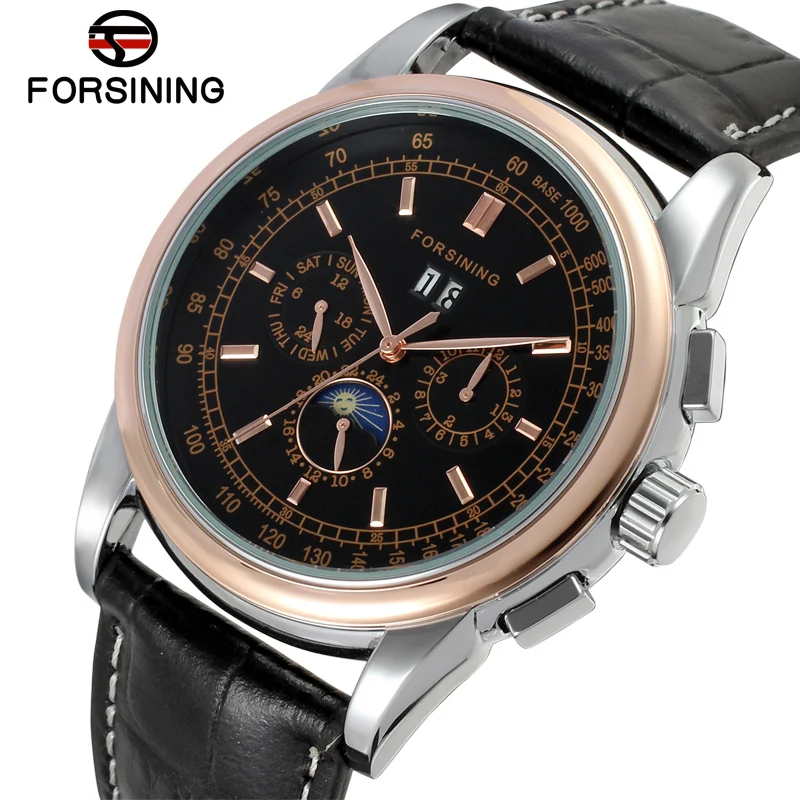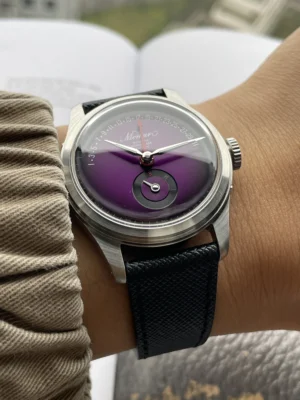Introduction: The Celestial Connection on Your Wrist
The moonphase complication stands as one of horology’s most poetic achievements—a tiny mechanical marvel that tracks the waxing and waning of our celestial companion right on your wrist. Unlike simple day/night indicators that merely show whether it’s AM or PM, a true moonphase complication displays the current phase of the moon exactly as it appears in the night sky, from new moon to full and back again.
What makes the moonphase so captivating to watch enthusiasts is its perfect marriage of technical ingenuity and artistic expression. On one hand, it represents a fascinating mechanical challenge: translating the moon’s irregular cycle into precise gear movements. On the other, it offers watchmakers a unique canvas for artistic interpretation—from photorealistic lunar surfaces to stylized golden moons with smiling faces.
This guide will take you through the inner workings of moonphase complications, explore their mechanical variations, examine the diverse design interpretations, trace their rich history, and explain why these celestial indicators continue to fascinate collectors despite our digital age. The connection between timekeeping and celestial movements runs deep, reflecting mankind’s ancient fascination with the stars and our place in the cosmos.
From the sophisticated astronomical moonphases that require adjustment only once every few centuries to simpler iterations found in accessible timepieces, the moonphase complication represents watchmaking’s ongoing dialogue with the history of dive watch engineering and other complex mechanical achievements.
The Lunar Cycle: Horological Challenge and Inspiration
At the heart of every moonphase complication lies a fundamental astronomical challenge: accurately representing the lunar cycle, which lasts precisely 29 days, 12 hours, 44 minutes, and 3 seconds. This irregular period—often rounded to 29.53 days—creates a significant horological puzzle that has engaged watchmakers for centuries.
The moon’s journey from new to full and back again doesn’t conveniently align with our 24-hour day or even our calendar months. This synodic month (the time between two identical lunar phases) requires watchmakers to develop ingenious mechanical solutions to translate this natural rhythm into the steady beat of gears and springs.
Beyond the technical challenge, the moon’s reliable yet ever-changing presence has fascinated humanity throughout recorded history. From ancient agricultural calendars to navigation guides for early explorers, the moon’s phases have served practical purposes while simultaneously inspiring art, mythology, and spiritual practices across cultures.
This deep connection to our natural world is precisely why moonphase complications hold such enduring appeal—they bring a slice of the cosmos to our wrist, connecting us to rhythms far more ancient than our human-made methods of timekeeping. The moonphase complication accuracy explained varies significantly between different implementations, reflecting the balance watchmakers must strike between precision, complexity, and cost.
Standard Moonphase Mechanisms: The 59-Tooth System Explained
The traditional moonphase mechanism elegantly solves the challenge of tracking the lunar cycle through a brilliantly simple design. At its heart lies a disc with 59 teeth around its perimeter and two moon representations on its face. This disc rotates beneath an aperture in the watch dial that frames the current phase of the moon.
Here’s how the standard 59-tooth system functions:
- The moonphase disc advances by one tooth each day, driven by the watch’s movement
- Each tooth represents approximately 29.53 ÷ 59 = 0.5 days of lunar movement
- The aperture in the dial acts as a frame, revealing only the portion of the moon that would be visible in the sky
- As the disc rotates, the moon appears to wax and wane through its complete cycle
- When one moon image disappears from the right side of the aperture, the second moon begins to appear on the left
This ingenious system creates a convincing illusion of the lunar cycle, but it does contain a slight mathematical imprecision. By dividing the lunar month into 59 increments rather than the actual 29.53 days, the standard mechanism accumulates an error of approximately one day every 2.5 years (or more precisely, 2 years and 7 months).
This means that a watch with a standard moonphase will require occasional adjustment to maintain astronomical accuracy. While this may seem like a drawback, many enthusiasts appreciate this interaction with their timepiece—a periodic ritual that reconnects them with the celestial rhythms their watch is designed to track. For a deeper technical explanation, explore how moonphase complications work in greater mechanical detail.
Advanced Moonphase Mechanisms: The Pursuit of Precision
While the standard 59-tooth moonphase mechanism serves most watch enthusiasts perfectly well, elite watchmakers have pushed the boundaries of precision with increasingly sophisticated designs. The most common advancement is the 135-tooth moonphase system, which represents a significant leap in accuracy.
With 135 teeth rather than 59, this enhanced mechanism reduces the error rate dramatically—requiring correction only once every 122.6 years. This remarkable precision means that most owners will never need to adjust their moonphase during their lifetime, much less pass that responsibility to the next generation.
For the most discerning collectors and astronomical purists, ultra-precise moonphase complications take accuracy to even more impressive heights. These exceptional mechanisms incorporate additional gearing to achieve deviations measured in centuries rather than years:
- High-precision mechanisms with accuracy to one day in 577.5 years
- Astronomical moonphases requiring correction only once every 1,058 years
- Ultimate precision models with accuracy approaching one day in 2,000+ years
Creating such precise mechanisms presents significant engineering challenges. Watchmakers must machine components to microscopic tolerances, develop specialized lubricants that won’t degrade over decades, and solve the puzzle of fitting these complex systems into the limited space of a wristwatch case.
These advanced moonphase mechanisms often appear alongside other sophisticated features in grand complication timepieces. The integration between mechanical watch calendar complications and precise moonphase indicators represents some of the finest achievements in contemporary horology.
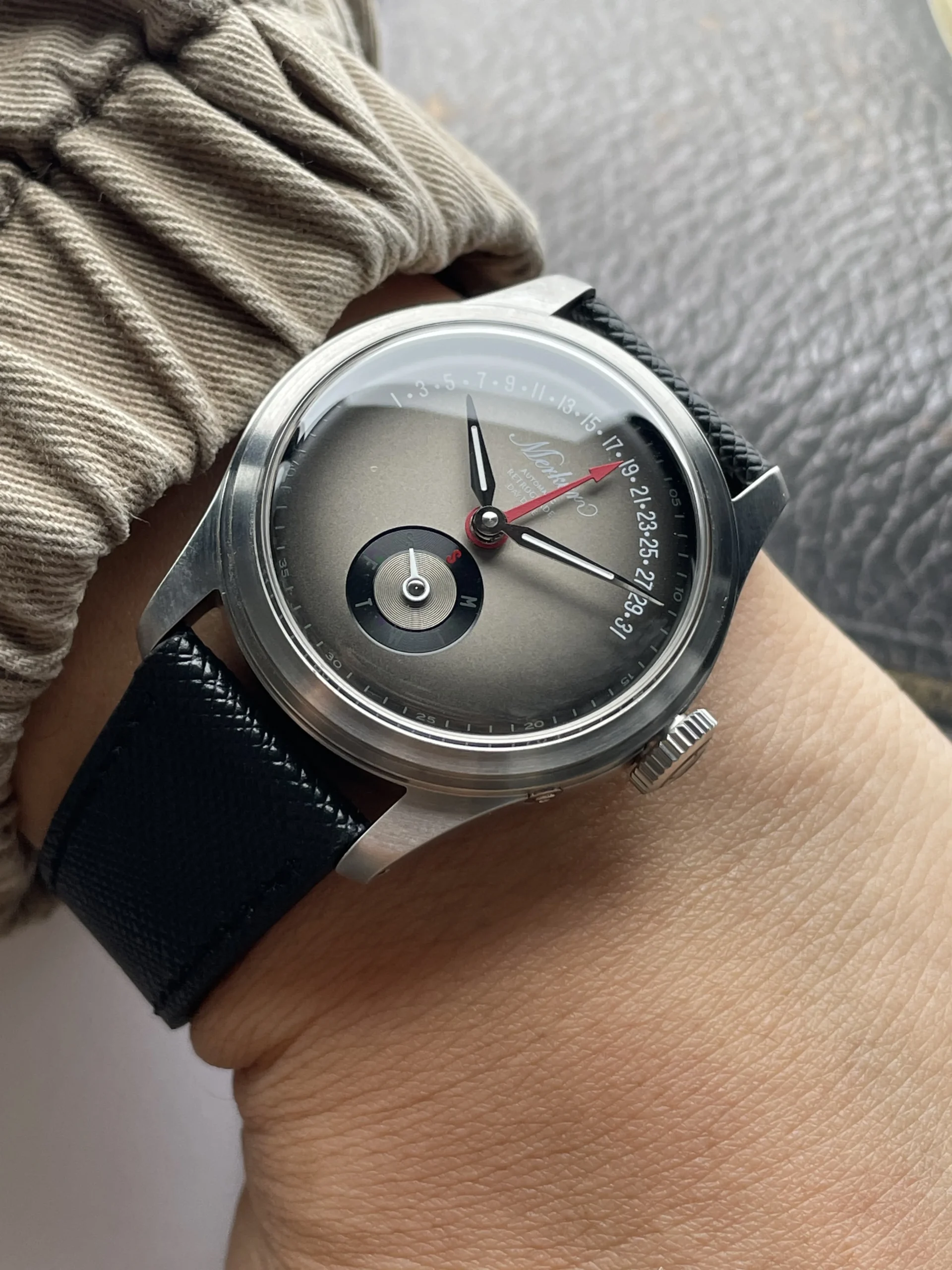
Setting and Adjusting Your Moonphase Watch
Properly setting and maintaining your moonphase watch ensures you’ll get the most enjoyment and accuracy from this beautiful complication. The adjustment mechanism varies between timepieces, with three common approaches:
- Crown position: Some watches allow moonphase adjustment through a specific position of the main crown
- Recessed pusher: Many moonphase watches feature a small corrector button flush with the case that requires a specialized tool
- Case side button: Some designs incorporate a dedicated pusher that can be pressed with a fingertip
To set your moonphase correctly:
- First, determine the current moon phase using a reliable calendar, weather app, or astronomical website
- If your watch has stopped, set it to approximately 6:00 before making any moonphase adjustments to avoid potential damage to the mechanism
- Advance the moonphase disc until it matches the current lunar phase
- Finish setting other functions (time, date) according to your watch’s instructions
Important safety tip: Avoid adjusting your moonphase between 9:00 PM and 3:00 AM when the date change mechanism is engaged. Making adjustments during this “danger zone” can potentially damage the delicate gears.
For ongoing maintenance, remember that standard moonphase mechanisms typically require correction every 2-3 years. Many enthusiasts enjoy this periodic ritual, using it as an opportunity to reconnect with their timepiece. For more practical insights, the ultimate guide to moonphase watches offers valuable maintenance tips and setting procedures for various watch types.
The Artistic Canvas: Design Interpretations of the Moonphase
The moonphase display represents one of watchmaking’s most distinctive aesthetic opportunities. While the mechanical principles may remain similar, the visual execution can vary dramatically, reflecting different artistic visions and brand identities.
The classic “bosom” or “arch” aperture design remains the most recognizable and traditional approach. This crescent-shaped window frames a rotating disc, revealing just the portion of the moon that would be visible in the night sky. The execution of this design can range from minimal and modern to ornately decorated with stars, clouds, or nighttime landscapes.
Beyond the traditional approach, watchmakers have developed numerous alternative display formats:
- Radial indicators that use a hand to point to the current phase along a semicircular scale
- Central moonphase displays where the lunar disc occupies the middle of the dial
- Double moonphase windows showing the moon as seen from both northern and southern hemispheres
- Rotating three-dimensional moon spheres that physically turn to show the correct phase
The artistic interpretation of the moon itself provides another dimension of creative expression. Some watchmakers opt for photorealistic depictions with detailed craters and texturing, while others embrace stylized representations including the traditional “man in the moon” face. The level of detail can range from simple printed discs to hand-painted miniature works of art.
Materials selection adds yet another layer of distinction. Traditional moonphase discs often feature gold or silver moons against a blue starry background, but contemporary watchmakers have expanded this palette dramatically:
- Aventurine glass creating a sparkling night sky effect
- Lapis lazuli or other blue stones for the night sky backdrop
- Meteorite material for the moon itself, creating a literal celestial connection
- Mother-of-pearl for subtle luminosity and organic texture
The integration of the moonphase display within the overall dial composition represents a crucial design consideration. Whether centrally featured or subtly integrated, the moonphase displays horology variations significantly impact the character and balance of the entire timepiece.
Historical Evolution: From Astronomical Clocks to Wristwatches
The tracking of lunar phases in timekeeping devices has a rich history spanning centuries. Long before the wristwatch era, medieval astronomical clocks in European town squares displayed the moon’s phase alongside the time, serving both practical and symbolic purposes for the community.
These early implementations were impressive feats of engineering—massive mechanisms housed in clock towers that displayed not just the moon’s phase but often its position relative to Earth and other astronomical data. As clockmaking technology advanced, these celestial displays were gradually miniaturized for domestic use in grandfather and mantel clocks.
The pocket watch era marked the next significant evolution. Watchmakers in the 18th and 19th centuries managed to compress the moonphase mechanism into portable timepieces, often creating “complete calendar” pocket watches that displayed the day, date, month, and moon phase. These complicated pocket watches represented the pinnacle of horological achievement in their day.
The transition to wristwatches in the early 20th century posed new challenges for moonphase complications. The dramatically reduced space required complete reimagining of the mechanism, making the moonphase complication relatively rare in early wristwatches and typically reserved for the most prestigious pieces.
After falling somewhat out of favor during the mid-20th century focus on sport and tool watches, the moonphase experienced a renaissance during the mechanical watch revival of the 1980s and 1990s. This resurgence coincided with renewed appreciation for traditional craftsmanship and complications, a trend that continues today.
The evolution of dive watch technology parallels many of the same miniaturization challenges that moonphase complications faced, though applied to different technical problems like water resistance and legibility.
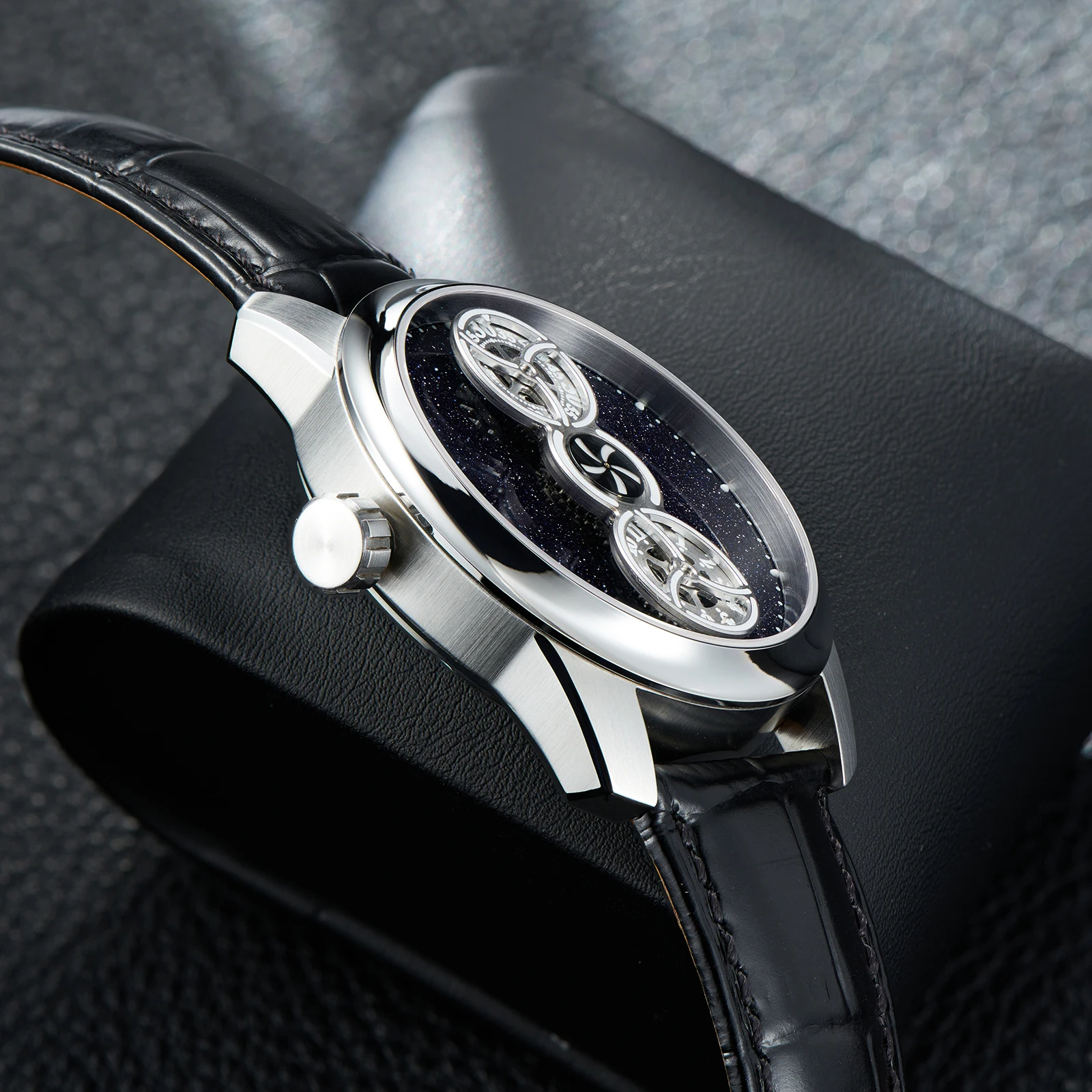
The Spectrum of Complexity: From Simple to Astronomical
Moonphase complications exist across a broad spectrum of complexity, from straightforward implementations in accessible timepieces to extraordinarily sophisticated astronomical wonders. This range offers entry points for collectors at virtually every level.
At the simpler end of the spectrum, basic moonphase indicators provide the essential function—tracking the lunar cycle through a traditional aperture—with standard accuracy requiring adjustment every few years. These approachable implementations often pair nicely with date functions in elegant dress watches.
Moving up the complexity scale, we find moonphases integrated with complete calendar systems that display the day, date, and month alongside the lunar phase. These more comprehensive calendar watches require thoughtful engineering to coordinate all functions harmoniously.
The pinnacle of complexity comes with astronomical moonphases paired with perpetual calendars. These horological marvels not only track the moon’s phase with exceptional precision but also automatically adjust for varying month lengths and leap years. The engineering challenges multiply exponentially with each additional function:
- More complex gear trains requiring precise calculation and manufacturing
- Increased power requirements that must be balanced against reserve duration
- Thicker movements that watchmakers must strive to keep reasonably proportioned
- Challenges in maintaining legibility despite displaying more information
The visual design must carefully balance complexity with clarity, ensuring that the watch remains readable despite its wealth of information. Some watchmakers opt for maximum legibility with clearly delineated displays, while others create more artistic interpretations where astronomy, art, and mechanics blend seamlessly.
Our moonphase automatic watches collection showcases timepieces across this complexity spectrum, from elegant simplicity to mechanical marvels.
Function vs. Romance: The Appeal of the Moonphase Today
In our smartphone-dominated world where the phase of the moon is just a tap away, what explains the enduring—indeed growing—appeal of mechanical moonphase watches? The answer lies in the unique combination of practical craftsmanship and emotional resonance.
From a strictly utilitarian perspective, a moonphase complication might seem superfluous. Few modern watch owners need to track the lunar cycle for practical reasons. Yet certain professions and activities still benefit from this knowledge—fishermen aware of how tides correspond to lunar phases, photographers planning nighttime shoots, or outdoor enthusiasts timing activities around natural moonlight.
The deeper appeal, however, transcends pure functionality. A mechanical moonphase creates a tangible connection to natural cycles often overlooked in our digital lives. There’s something profoundly satisfying about glancing at your wrist and seeing the same moon phase that illuminates the night sky—a small reminder of our place in the larger cosmos.
This connection to natural rhythms offers a counterpoint to our increasingly virtual existence. While smartwatches and phones measure time in milliseconds and notify us of every digital happening, a moonphase watch quietly tracks a celestial cycle that has remained unchanged for billions of years.
The moonphase also represents a celebration of traditional craftsmanship. In an age of planned obsolescence, these mechanical marvels are designed to run for generations when properly maintained—a sustainable approach to ownership increasingly valued by discerning consumers.
For many collectors, perpetual calendar automatic watches with integrated moonphase displays represent the perfect synthesis of technical sophistication and romantic appeal.
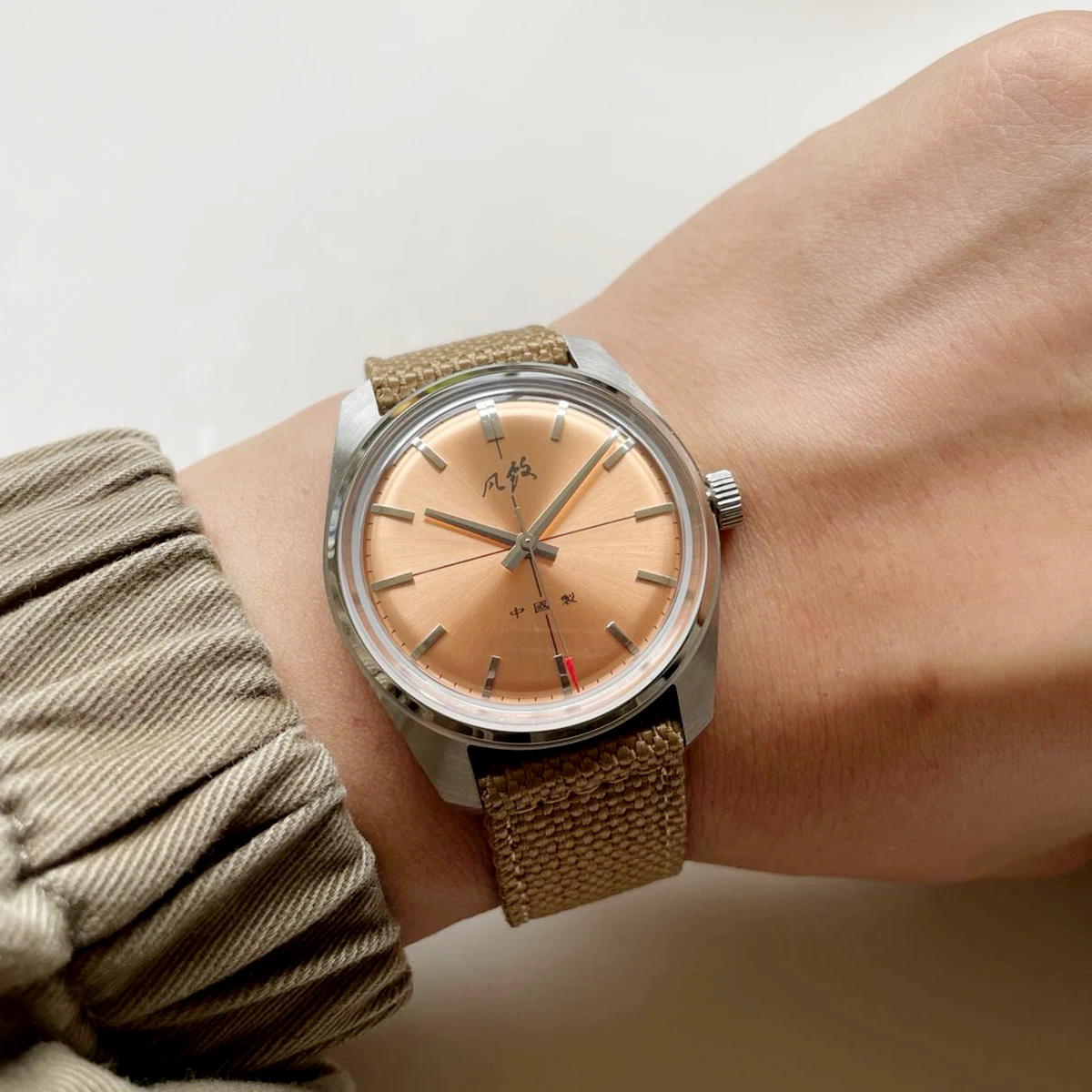
Classic Automatic Dress Watches, Day Date Automatic Watches, Perpetual Calendar Automatic Watches
Price range: $540.60 through $574.60 Select options This product has multiple variants. The options may be chosen on the product pageClassic Automatic Dress Watches, GMT Automatic Watches, GMT Pilot Watches
Price range: $1,240.86 through $1,463.33 Select options This product has multiple variants. The options may be chosen on the product pageAutomatic Skeleton Watches, Open Heart Automatic Watches
$98.36 Select options This product has multiple variants. The options may be chosen on the product pageClassic Automatic Dress Watches, Thin Automatic Dress Watches
$437.64 Select options This product has multiple variants. The options may be chosen on the product page- $480.96 Select options This product has multiple variants. The options may be chosen on the product page
Classic Automatic Dress Watches, GMT Automatic Watches, GMT Dive Watches
Price range: $468.93 through $552.94 Select options This product has multiple variants. The options may be chosen on the product page
Collector’s Considerations: What to Look For in a Moonphase Watch
When evaluating moonphase watches for your collection, several key factors help distinguish exceptional examples from merely adequate ones:
Mechanism Accuracy
– Standard 59-tooth systems (correction every 2.5 years) are perfectly acceptable in entry and mid-level pieces
– 135-tooth systems (correction every 122 years) represent a significant quality upgrade
– Ultra-precise astronomical moonphases indicate exceptional movement quality
Design Execution
– Evaluate the moonphase disc’s artistic quality—hand-painted moons generally command premium value
– Consider the integration of the moonphase display within the overall dial composition
– Look for depth and dimension in the moonphase aperture that creates visual interest
– Assess the color harmony between the night sky backdrop and other dial elements
Movement Quality
– Examine the overall finishing visible through a display caseback
– Consider the power reserve—longer reserves are particularly valuable in complicated watches
– Note whether the moonphase is part of a module attached to a base movement or integrated into the movement design
Practical Considerations
– Verify the adjustment mechanism—recessed pushers require special tools while crown-operated systems offer convenience
– Consider case size relative to complexity—more complications often require larger cases
– Assess dial legibility—some artistic moonphases sacrifice readability for aesthetic impact
Even in more accessible price segments, a well-executed moonphase should show attention to detail in the disc printing, accurate alignment within the aperture, and smooth operation when adjusted. The difference between exceptional and average execution becomes apparent in these subtle details.
For collectors exploring mechanical complications, open heart automatic watches offer another fascinating window into watchmaking artistry that complements the celestial appeal of moonphase displays.
Conclusion: The Timeless Allure of Tracking Celestial Time
The moonphase complication embodies watchmaking’s most compelling duality: it is simultaneously a technical achievement and an artistic expression, a functional tool and a romantic gesture. This blend of precision engineering and celestial poetry explains its enduring appeal across centuries of horological development.
What makes the moonphase particularly special is how it connects the wearer to something larger than themselves. While every watch measures the passage of time, the moonphase uniquely links that measurement to the cosmos—the same celestial dance that has fascinated humanity since we first gazed skyward.
In today’s digital world, mechanical moonphase watches offer something increasingly rare: a tangible connection to natural cycles and traditional craftsmanship. They remind us that before time was measured in nanoseconds and synchronized by atomic clocks, humans looked to the heavens to understand their place in the rhythm of days, seasons, and years.
Whether you’re drawn to the technical sophistication of an astronomical moonphase, the artistic beauty of a hand-painted lunar disc, or simply the romance of wearing the night sky on your wrist, unique automatic watches with moonphase complications offer something increasingly valuable—a moment of contemplation in our accelerated world. For those seeking a more traditional aesthetic, classic automatic dress watches often incorporate moonphase displays with timeless elegance.

